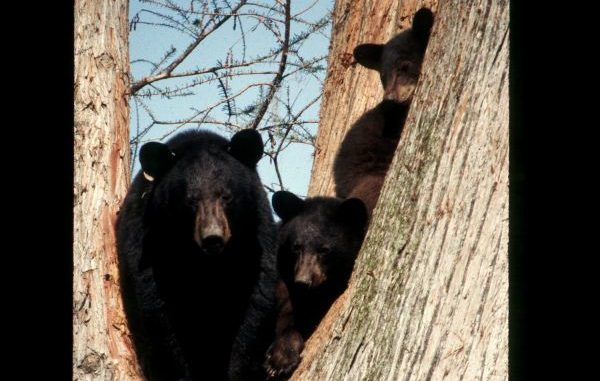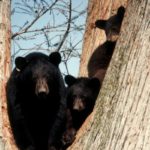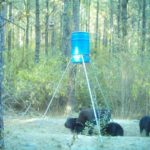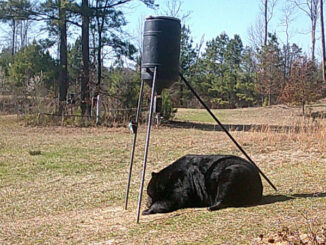
I like bears. I like black ones, brown ones and white ones, and I like the fact they still roam free in some of their original habitat ranges. The wild places just wouldn’t seem quite as wild without the bear.
Early in my career, only a few bears remained in the state. But I was glad they had managed to hang on and was thrilled one day when we found fresh bear tracks on Grassy Lake WMA in Avoyelles Parish.
Some years later, the Louisiana black bear was listed as threatened on the Federal Endangered Species List. At that point both U.S. Fish & Wildlife Service and the Louisiana Department of Wildlife & Fisheries initiated studies and relocation efforts.
Those cooperative efforts continue to this day, involving biologists and law enforcement officers at both state and federal levels.
Wildlife biologists study and monitor bear populations, and undertake reintroduction into favorable habitat and historical ranges where bears have not moved in on their own.
Law enforcement is charged with enforcing regulations protecting bears and investigating violations such as illegal kills.
Both management and enforcement are difficult tasks, and progress has not been quick or easy.
Historically in Louisiana, bears were found throughout the state, but primarily along the Mississippi River Valley and Atchafalaya Basin. The two river systems are linked by what we have come to know as the “bear corridor” that runs roughly through Iberia, St. Martin, Iberville and Pointe Coupee parishes. Repatriation efforts have occurred in the corridor, and in favorable habitat in areas such as Avoyelles Parish in order to link populations along the Mississippi and Atchafalaya rivers.
Maria Davidson is the LDWF’s large carnivore biologist and charged with managing the black bear program. Davidson is one of the most-dedicated people at LDWF, spending countless hours both on and off the clock working on behalf of bears. It is not at all unusual for Davidson to be first on the scene for a problem bear or illegal kill notification
Enforcement agents know her as “The Bear Lady.”
According to Davidson, graduate-student studies have yielded very accurate population estimates on bears in the Tensas area (historically a black bear stronghold) and Pointe Coupee. University of Tennessee graduate student Mike Hooker did a population study in the Tensas area from 2006 to 2009 for his thesis, and he reported 292 bears at the end of his study. Carrie Lowe, also of University of Tennessee, completed the Pointe Coupee study in 2011 and reported 56 bears.
“Those numbers are not a guess,” Davidson said. “They are based on counts at bait stations set at one per square mile.”
Bears in Louisiana are not without controversy, although much of the opposition is based on fear and misunderstanding.
Stephen Herrero is a professor with the University of Calgary and a recognized authority on bears. In his book “Bear Attacks: Their Causes and Avoidance,” he writes, “Of all the animals in North America, none commands as much respect, interest, awe and fear as the bear.”
Davidson agrees, pointing out that in Louisiana bear behavior is largely misunderstood because we have no experience with them. In fact, bear attacks are extremely rare anywhere, even in areas where bear numbers are high. Black bears are usually very shy and reclusive.
“Hundreds of close encounters with bears take place, and the human never knows it happened,” said Davidson.
From an enforcement standpoint, I can certainly testify to an abundance of misunderstanding. Rarely have I ever had a conversation or made a presentation involving bears when someone did not pose this question: “What if a bear attacks me?”
My standard answer was, “You are more likely to get struck by lightening while sitting in your tree stand. I’d spend a lot more time thinking about how to avoid the conflict as opposed to what to do during or after.”
In all the cases in recent history in Louisiana where bears were killed illegally — that we know about — only one remotely involved fear of attack. That incident took place during the spring gobbler season when a turkey hunter flushed a bear from thick cover. In startle response, the hunter shot the fleeing bear, was honest enough to report it and later admitted he should not have shot.
The case was not prosecuted and, all things considered, that was probably best.
The same cannot be said in other cases. One of the worst in my recollection was in the Tensas area where a deer hunter saw a bear, knew it was a bear, shot it and went for a closer look. After a brief examination he dragged the smallish bear over to a bayou, rolled it in and fled.
He later related the story to someone who reported it. Wildlife agents recovered the bear and arrested the suspect. He admitted to killing the bear. His explanation for killing it was that he had never seen one before.
Most deer hunters do not like bears, and we all know why. BEARS LOVE CORN.
And they pretty much love any other feed placed for deer. That super sense of smell brings bears right in to deer-baiting sites where they can wreak havoc on feeders.
But love them or hate them, bears are here, and they may well show up in unexpected areas of the state. We are already seeing bears as far west of the Mississippi as Grant Parish. They do remain on the Endangered Species list at the threatened level, and Davidson emphasizes the state’s best option is de-listing.
“Removing bears from the Endangered Species List will allow us to implement meaningful management, including significant harvest,” she said.
Most of the complaints and dire predictions about bears are not based on reality, and LDWF sees the need to not only act as a professional managing entity but also to teach people how to deal with bears, because, as Davidson points out, “We can’t teach bears to deal with people.”
So where are we with the Louisiana black bear? LDWF is currently in the analysis stage of the de-listing process. By the spring of 2014, they’ll know more about when de-listing will occur. In the meantime, the agency is focused on future management of bears and is seeking public input.
Anyone with a bear or bears on their property or hunting lease is urged to contact the private-land biologist in your local LDWF region office for advice on what and what not to do.
To report violations or suspected violations involving bears or any other wildlife, for that matter, speak with the law enforcement captain or your local wildlife enforcement agent.




